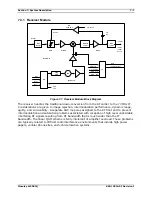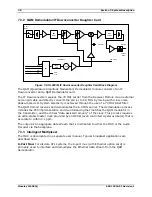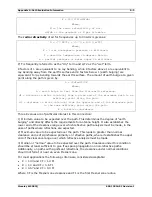
Appendix B: Audio Considerations
B-1
Moseley SL9003Q
602-12016-01 Revision J
B. Audio
Considerations
B.1 Units of Audio Measurement
B.1.1 Why dBm?
In the early years of broadcasting and professional audio, audio circuits with matched
terminations and maximum power transfer were the common case in studios and for audio
transmission lines between facilities. Console and line amplifier output impedances,
implemented with vacuum tube and transformer technology, were typically 600 Ohms.
Equipment input impedances, again usually transformer-matched, were also typically 600
Ohms. Maximum power transfer takes place when the source and load impedances are
matched. For such systems, the dBm unit (dB relative to one milliwatt) was appropriate
since it is a power unit.
B.1.2 Audio Meters
However, actual power-measuring instruments are extremely rare in audio. Audio meters
and distortions analyzers are voltmeters, measuring voltage across their input terminals.
They do not know the power level, current value, nor source impedance across which they
are measuring, Since the audio industry had “grown up” with 600 Ohm power-transfer
systems in common use, audio test instrument manufacturers typically calibrated their
voltmeters for this situation. Most audio test instruments and systems manufactured before
approximately 1985 used only Volts and the dBm unit on their meter scales and switch
labels. The dBm unit was calibrated with the assumption that the meter would always be
connected across a 600 Ohm circuit when measuring dBm. Since the voltage across a 600
Ohm resistor is 0.7746 Volts when one milliwatt is being dissipated in that resistor, the
meters were actually calibrated for a zero “dBm” indication with 0.7746 Volts applied. But,
they were not measuring power; change the circuit impedance, and the meter is incorrect.
B.1.3 Voltage-Based Systems
Modern audio equipment normally has output impedances much lower than input
impedances. Output impedance values from zero up to 50 Ohms are typical, and input
impedances of 10 kilohms are typical. Such equipment, connected together, transfers
negligible power due to the large impedance mismatch. However, nearly all the source
voltage is transferred. As noted earlier, a 10 kilohm load reduces the open-circuit voltage
from a 50 Ohm source by only 0.5%, or 0.05 dB. Thus, modern systems typically operate
on a voltage transfer basis and the dBm, as a power unit, is not appropriate. A proper unit
for voltage-based systems is the dBu (dB relative to 0.7746 Volts). The dBu is a voltage unit
and requires no assumptions about current, power, or impedance. Those older audio meters
calibrated in “dBm” are really dBu meters.
B.1.4 Old Habits Die Hard
Unfortunately, the “dBm” terminology has hung on long after its use is generally
appropriate. Even some of the most competent manufactures of high-technology digital and
analog professional audio equipment still use the dBm unit in their setup instructions. Users
are told to apply an input signal of “+4 dBm” and then to adjust trim pots for an exact 0 VU
indication on a 24-track digital audio tape recorder, for example. Yet, the line input
impedances of that tape recorder are 10 kilohms. What the manufacturer clearly wants is a
+4 dBu input level (1.22 Volts). If we truly a4 dBm to that 10,000 Ohm input, the
resulting 5.0 Volts would probably not even be within the trim pot adjustment range for 0
VU. So, a good general rule when working with modern audio equipment unless you know it
to be terminated in 600 Ohms is to read the manufacturer’s “dBm” as “dBu”.
Summary of Contents for Starlink SL9003Q
Page 86: ...5 22 Section 5 Module Configuration Moseley SL9003Q 602 12016 01 Revision J ...
Page 90: ...6 4 Section 6 Customer Service Moseley SL9003Q 602 12016 01 Revision J ...
Page 110: ...A 10 Appendix A Path Evaluation Information Moseley SL9003Q 602 12016 01 Revision J ...
Page 118: ...D 2 Appendix D Microvolt dBm Watt Conversion 50 ohms Moseley SL9003Q 602 12016 01 Revision J ...
















































